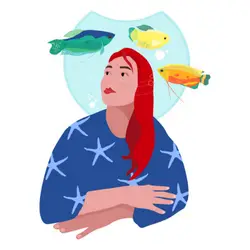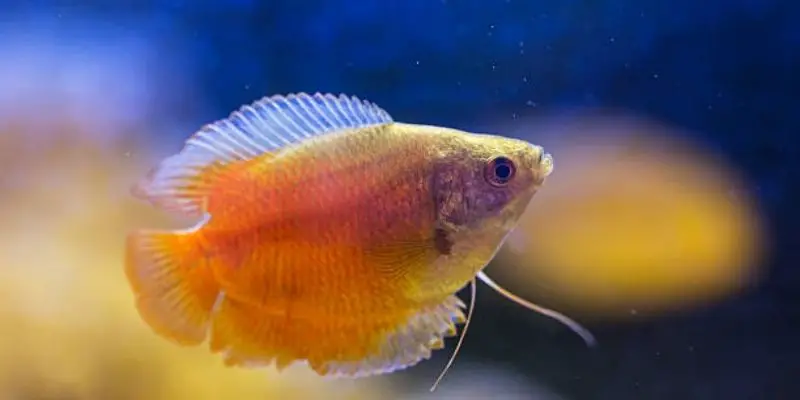Dwarf Gouramis are well known for being bubble nest builders in aquariums, but why do they build bubbles? What exactly is going on in the tank when you see them blow bubbles? As with most behaviors in fish, there are various reasons why your Dwarf Gourami may be blowing bubbles.
There are cases where it could be an illness, a stressor from the environment of your aquarium, or even normal function.
Anatomy of the Bubble Nest
Your Dwarf Gourami will create a mucus bubble nest to surround itself in. These nests are built by males to attract females for mating. When taking care of your Dwarf Gourami, you’ll want to make sure that there is some form of vegetation or branches within the tank where bubbles can be attached.
This will increase the likelihood of your female accepting the male’s advances, as she feels more secure next to some sort of structure.
You may also see bubbles on some plants or driftwood in your aquarium. These are generally attached to decorations within the tank and not built by the fish themselves.
You won’t see them blow these bubbles like the ones built within the bubble nest, but they may release some later on to give their efforts a boost.
Environmental Factors
Several environmental factors could cause your Dwarf Gourami to blow bubbles:
pH
The pH of your water can play a significant role in your Dwarf Gouramis operations. Most aquariums are run within the ideal range of 6-8 for pH. Some reports have shown that at lower levels, your fish may become more aggressive towards other fish or even to themselves.
This is primarily due to the stress the water puts on their bodies at lower pH levels, which can cause increased aggression.
At higher pH levels, your Dwarf Gourami may release too much oxygen into the water. This causes their bubble nests to collapse because of the high amount of dissolved gasses in the water.
For this reason, it’s best to stay within the 6-8 range for good health and bubble nest success.
Temperature
The temperature within your aquarium can help or hinder your Dwarf Gourami in a couple of ways. For one, egg fertility is increased in higher temps. This means that a higher temperature will cause a female to be more likely to lay eggs within the bubble nest.
However, high temperatures have been known to reduce the amount of oxygen dissolved in the water. If there is too little oxygen in the water, your bubble nest can collapse within a day because it is not being replenished with new bubbles.
To ensure that there is enough oxygen in the water, make 50% weekly changes of fresh, dechlorinated freshwater. Dissolved Oxygen Levels for Gouramis are > 6 ppm.
Diet
The dietary habits of your Dwarf Gourami can also affect their behavior. Overfeeding food within the tank can cause a high amount of nutrients to pollute the water column.
This can be particularly harmful to fish that lay eggs, as their fry relies on a clean water column to survive.
Overfeeding is also known to cause your Dwarf Gourami to release too many bubbles into the water. This can be a result of their bodies not being able to metabolize all of the food they’re eating.
The uneaten food then decomposes and releases ammonia, which causes your fish stress and can harm or even kill them if left unchecked.
Changes
Any drastic change in their environment can cause your Dwarf Gourami to blow bubbles as a result of stress. This includes things such as a water change, new decorations within the tank, or an addition or subtraction of any other fish or plants from the aquarium.
To ensure that changes within the tank do not affect your Dwarf Gourami’s behavior, make sure to do them gradually. First, add about half of the water from your old tank to a bucket, and then slowly replace it with fresh water from the tap over the next hour or so.
While taking care of your Dwarf Gourami, you can also help minimize stress by ensuring that there is plenty of cover within the tank for protection.
The Effects of Bubble Nest Construction
If you are seeing bubbles slowly rise to the surface of your tank, it could be time for your Dwarf Gourami to make a bubble nest. This is normal behavior within their natural habitat because they build these nests to lay eggs.
Once they feel that the time is right, males will spit out the mucus that forms the base of the nest. Then, they will continue to spit out more and more bubbles until their entire body is covered with them. Once this is complete, they will start releasing eggs one by one into the bubble nest.
Once an egg has been laid in a bubble nest, it absorbs all of the gasses from the bubbles and gets lighter than the liquid within the tank, causing it to float upwards.
The male will continue to spit out more and more bubbles as needed to keep the eggs float above the surface of the water. This allows them easy access to oxygen while keeping them away from any debris that may be floating around in the tank.
As the eggs are being cared for within their bubble nest, the male will continue to spit out more and more bubbles to protect them from predators. He doesn’t want anything to happen to his future offspring, so he works diligently every day making sure that their home is safe for them.
If you see your Dwarf Gourami blowing bubbles, you must leave them to do their work. If they are blowing bubbles, it means that they are building a nest to lay eggs, so the last thing you want to do is interrupt them with your net or disturb them in any way.
If there is no bubble nest present within your tank after several days of observing your Dwarf Gourami, there is a chance that they are ill. This could be the result of something such as a water quality issue or illness from another fish within the tank.
If you suspect that there is an issue with your fish, it’s important to take them out of the water and examine them thoroughly.
Be sure that there is plenty of cover present within the tank to reduce stress and allow them to feel secure. Avoid any changes within the tank, and slowly add freshwater while adding new decorations to ensure that they don’t cause your Dwarf Gourami too much stress.

